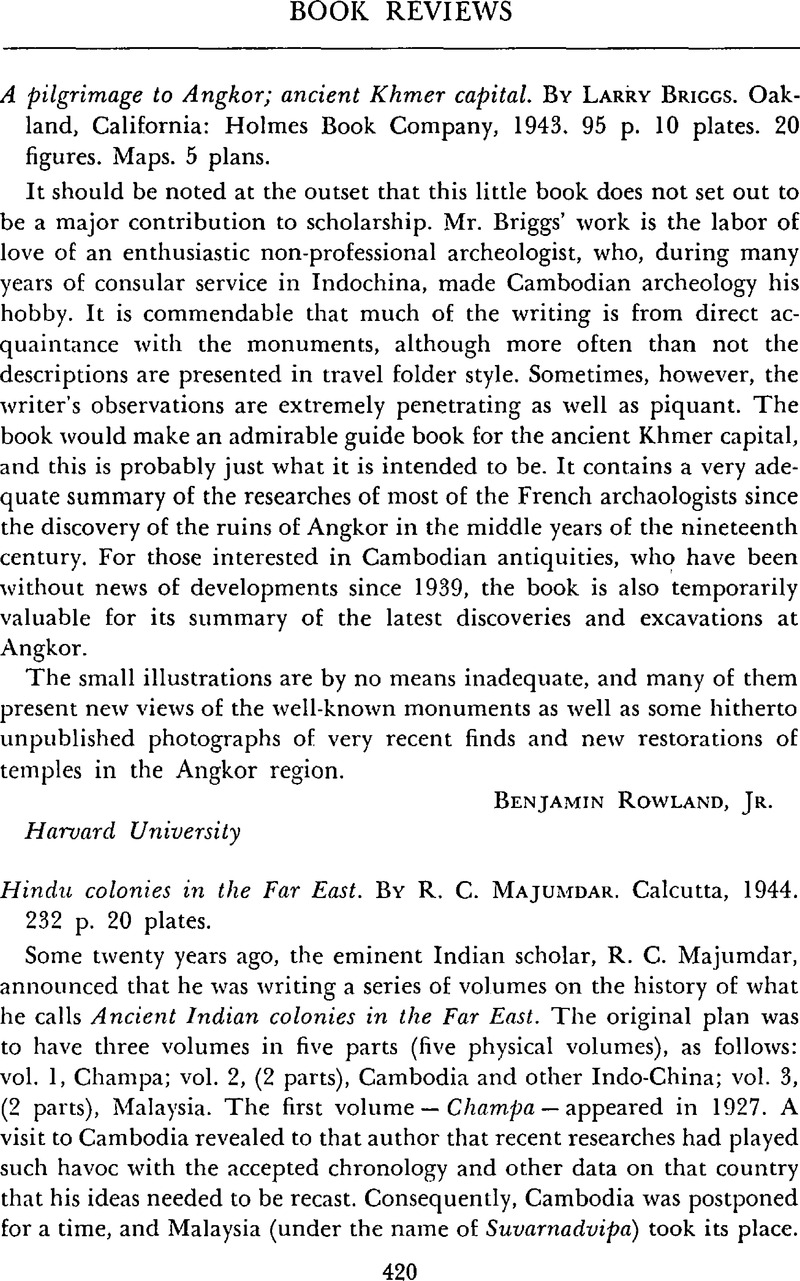No CrossRef data available.
Published online by Cambridge University Press: 23 March 2011

1 Since Buddhism is probably as old as Brahmanism in this region, this reviewer prefers the term “Indianized”.
2 Pelliot, Paul, “Le Fou nan,” Bulletin de l'ecole français d'Extrême-Orient (DEFEO), 3 (1903), 286–87Google Scholar.
3 Moura, J., Le royaume du Cambodge (Paris, 1883), vol. 2, pp. 9–10Google Scholar.
4 Maspero, Georges, Le royaume de Champa (Paris, 1928), 55–59Google Scholar.
5 R. C. Majumdar, Champa, part 3, pp. 1–3.
6 G. Maspero, op. cit., pp. 49–51.
7 Mme. Gilberte de Coral-Rémusat, “Animaux fantastiques de l'lndochine, de l'Insulinde et de la Chine,” BEFEO, 36 (1936), 427–35.
8 Briggs, Lawrence Palmer, “A sketch of Cambodian history,” Far Eastern quarterly (FEQ), 6 (August 1947), 348CrossRefGoogle Scholar.
9 Lawrence Palmer Briggs, “The treaty of March 23, 1907 between France and Siam and the return of Battambang and Angkor to Cambodia,” F£Q, 5 (August 1946), 440–41.
10 Ibid., p. 440.
11 Maspero, G., “La geographie politique de l'Indochine aux environs de 960 A. D.” Etudes asiatiques, 2 (Hanoi, 1925), 92–94 and mapGoogle Scholar.
12 Hermann, Albert, Historical and commercial atlas of China (Cambridge, Mass. 1935), 15–18Google Scholar.
13 Aurousseau, Leonard, “La premiere conquete chinois des pays annamites” BEFEO, 23 (1923), 137–266Google Scholar.
14 Verneau, R., “Les cranes humaines du gisement prehistorique de Pho-Binh-Gia,” L'anthro-pologie, 20 (1909), 544–59Google Scholar.
16 Coedès, George, “Les capitales de Jayavarman II,” BEFEO, 28 (1928), 117–19Google Scholar.
17 Groslier, Georges, “Amarendrapura dans Amoghapura,” BEFEO, 24 (1924), 388–92CrossRefGoogle Scholar.
18 Stern, P., “Le temple-montagne Khmer,” BEFEO, 34 (1934), 611–17CrossRefGoogle Scholar.
19 Mine Gilberte de Coral-Rémusat, L'art Khmer (Paris, 1940), 11.
20 BEFEO, 33 (1933), 527;DEFEO, 35 (1935), 574–77.
21 E. Aymonier, Le Cambodge, vol. 3, p. 322.
22 Moura, op. cit., vol. 2, p. 11.
23 Mémoires archéologiques, publié par l'EFEO, tome 2: Le temple d''Angkor Wat, premier partie, introduction by Louis Finot, p. 6, note 2.
24 Aymonier, op. cit., vol. 3, p. 291.
25 Coèdes, “Les bas reliefs d'Angkor Wat,” Bulletin de la commission archéologique Indo-chinoise (1911), 213–16.
26 See articles by Ph. Stern and Pierre Dupont, in BEFEO, 1936 and 1938.
27 Stern, Philippe, “Travaux executées au Phnom Kulen (15 April-20 Mai, 1936),” BEFEO, 38 (1939), 155Google Scholar.
28 Mme Gilberte de Coral-Rémusat, L'art Khmer, pp. 117–18, 128.
18 Briggs, “A sketch of Cambodian history,” ibid., p. 350.
30 Aymonier, op. cit., vol. 1, p. 57; R. G. in Indochine hebdomadaire illustré, Hanoi, Nov. 20, 1941.
31 G. Coedes, “L'inscription de Baksei Ĉamkron,” Journal asiatique (May-June 1909), 467–503.
32 Bergaigne, Abel, “Inscriptions sanscrites de Cambodge,” Académie des inscriptions et belles lettres. Notices et extraits des manuscrits (Paris, 1885), 303Google Scholar.
33 Briggs, Lawrence Palmer, “Dvaravati, the most ancient kingdom of Siam,” Journal of the American Oriental society, 65 (April-June 1945), 104CrossRefGoogle Scholar.
34 Briggs, “A sketch of Cambodian history,” ibid., p. 351.
35 Coedès, G., “Une inscription d'Udayadityavarman I,” BEFEO, 11 (1911), 400–04Google Scholar.
36 L. Finot, “Sdok Kak Thorn.” op, cit., p. 91.
37 C. Coedes, “La stele de Ta Prohm,” BEFEO, 6 (1906), 45, 72.
38 Briggs, Larry, A pilgrimage to Angkor (Oakland, 1943), 35Google Scholar.
39 Mme de Coral-Rémusat, L'art Khmer, pp. 117–18, 119, 120,128, 129.
40 Parmentier, Henri, “L'art d'Indravarman,” BEFEO, 19 (1919), 1–91Google Scholar.
41 Blagden, C. O., “The Pyu inscriptions,” Journal of the Burmese research society, 7, pt. 1 (1917), 37–41Google Scholar.
42 Briggs, Dvaravatī, op. cit., pp. 99–102.
43 Ibid., p. 103.
44 Ibid., p. 105.
45 Ibid., pp. 99–101, 105.
46 Parmentier, Henri, “L'art pseudo-Khmer au Siam et la Prang,” Journal of the Greater India society, 4 (1937), 1–25, 97–116Google Scholar.
47 Boulanger, Paul Le, Histoire du Laos fran¸ais (Paris, 1931), 30–36Google Scholar.
48 J. B. Pallegoix, Description du royaume Thai, ou Siam, vol. 2, p. 64.